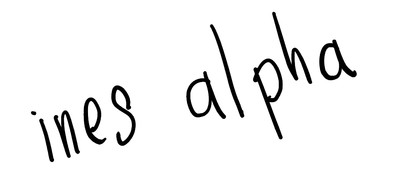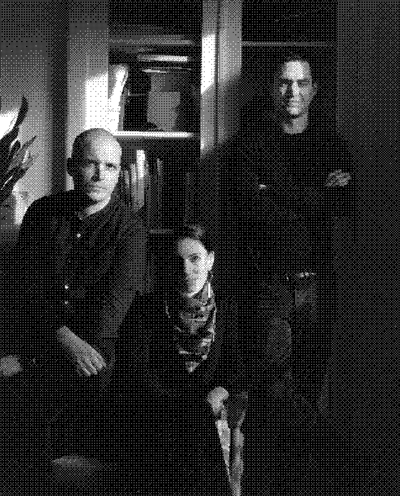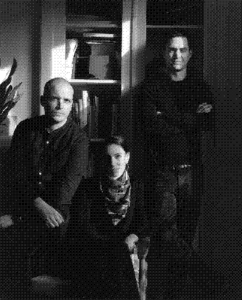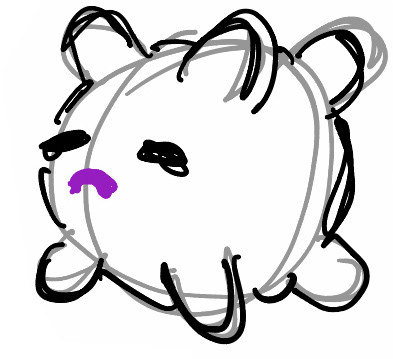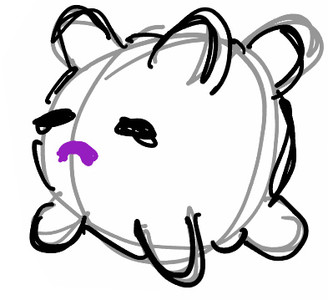Could you introduce yourself?
I’m Inès Alpha, digital artist, specialised in what I call 3D makeup.
I do post-production and augmented reality.
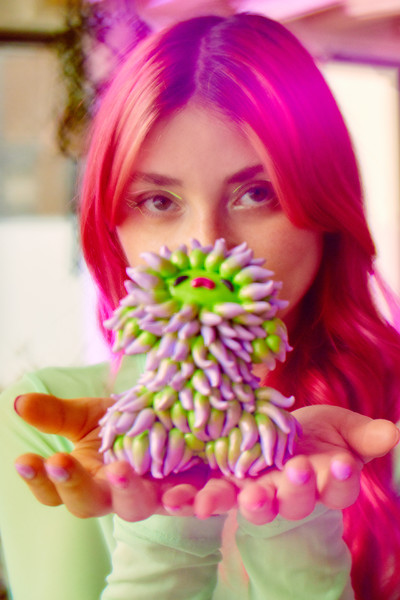
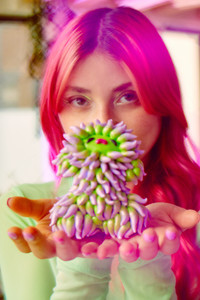
Ines Alpha, Photo: Diane Sagnier
So that’s how you present your work. Do you consider it “work” by the way?
I’ve found it difficult to see it as work. I didn’t think it was going to become a job, but that’s what it is today. Makeup artist is a job, so why not digital makeup artist or 3D makeup artist? For me, that’s always been very clear. But before I got my first commissions, it was a fantasy, a job in my head.
Was that your first job?
I was an art director at an advertising agency that specialised in makeup, cosmetics, beauty, luxury, fashion…

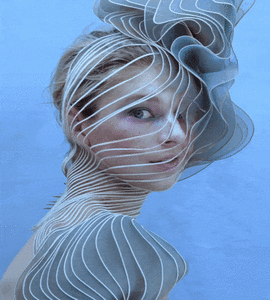
ALLURE magazine × Hunter Schafer

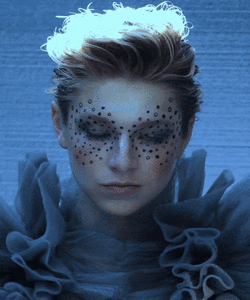
ALLURE magazine × Hunter Schafer
What is your state of mind at the moment?
I didn’t expect this question at all, to jump from my work to my state of mind. Suddenly, all I can see are storm clouds, the end of the world. I just had a nightmare about the end of the world [laughter].
Right now, it’s complicated. It’s a little dystopian. So many shitty things are happening in the world. I’m not very optimistic. But a lot of good things are happening too. But I always feel like no matter what positive things happen, human beings always turn it to shit. We’re really never going to change. It’s complicated. Whether it’s my computer crashing—Well, that’s not human beings’ fault, it’s Mircosoft’s, who are incapable of making a stable operating system—or whether it’s war, WEB3, the metaverse… We have new tools to create an alternative to this world and make something good, something healthy. And you always get the feeling that things are going in the wrong direction.
We’ll come back to that bit about the future. I imagine you’re going on holiday this summer, but do you have any interesting projects lined up for the fall?
The period after summer holiday is going to be pretty intense. So I want to take advantage of my time this summer without commissions to start/finish some collabs that have been dragging on for months. I try to find a balance, to have enough time in the year for personal projects, to recharge my creative batteries, and to take advantage of opportunities to meet people and do collabs that are enriching for me.
Client commissions are usually pretty safe: things I already know how to do that reassure me. To really get out of my comfort zone, I need time and a budget to try working with people that know how to do things that I don’t know how to do. If I have to do everything all on my own, I start to panic…
You started in an agency doing cosmetics. Were you already doing 3D or was it also on the side?
I started out doing 3D on the side. When I was working as an art director for cosmetics campaigns, I did marketing campaigns with models and still lives, so when I started doing 3D, I thought, “I’m going to create my models with 3D.” During those last couple years at the agency, that was probably my favourite thing to do. It made me flip out to replicate the textures and shapes of the packaging, to make little flowers, my little set-up. The risk, and this happened to me, was that the client might prefer the 3D to the final photography.
And that’s when you decided you could start your own business?
It was a mixture of a lot of things. Part of it was me being fed up, and part of it was me going, I like this tool, maybe I can do this on my own.
And the idea of bringing makeup into 3D, how did that idea come to you?
It didn’t come right away. I started doing 3D sort of just for fun. During that time, I met PANTEROS666 in the agency where I worked. He was a planner. He needed someone to help him with the visuals and then the clips and I told him, “Uh hold on, I know these tools. Let’s do this together actually.” I started with clips. First by adding 3D to real environments because it saved me time. I’ve always tried to look for my own identity, a kind of personal concept, and that’s something I had never found before.
What did you study?
Applied art. I liked everything somewhat, but I didn’t know what I was truly made for. And I would draw and ask myself, “What is your pencil stroke?” I would try doing exercises. I had to find my story, my path.
It was the same thing when I launched my solo career. I said to myself, “I just have to do this for a few months, a year, and I’ll specialise in this. And we’ll see where it takes me. At the beginning, I didn’t do 3D makeup at all. I had tried recreating plants from a book I’m sure you know, called The Codex Seraphinianus, to bring them into this world and give them volume and perspective. And in the meantime, I got the idea of 3D makeup. At the agency, I was doing beauty models with skin, closeups of faces, and on the side, I was doing clips where I was adding 3D elements into landscapes, so I thought, “Why not do this but for faces?” I had never seen that before. And that’s kind of how I got into it. My VERY first experiment was on a photo of Jamie Nelson.
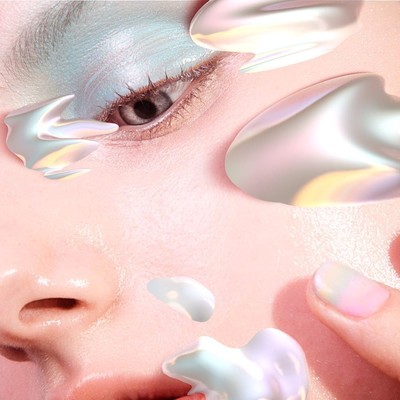
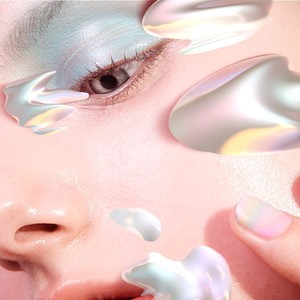
Photos: Jamie Nelson, 3D make up by Ines Alpha
Were you a pioneer in this field?
Yeah, well… that still sounds a bit pretentious. Adding 3D elements, of course that had been done before in post-production. People often compare my work to this one Bjork video, where she turns into a lion. These are special effects. What was more original was to say, “Today, makeup means pigments that get put onto a face. My pigments are made of pixels, and pixels with volume rendering. I had never seen anyone do it like that before. I saw people creating faces in 3D but with objects, or appliques with volume rendering, but not that. I discovered artists like James T Merry, who did all the masks for Bjork, or Hungry, who is a performance artist. I wanted to transform faces as well and add volume elements, but with my own tools. I think I’ve been a pioneer in this field, and I can be proud of that.
That’s when you found your own “stroke” then?
My style can’t be just adding 3D elements to a face. But I think that after having used the software, after having deepened my practice, there are now recognisable elements—inspirations, colours, textures, shapes—that stand out. So little by little, my style has become defined, rather naturally.

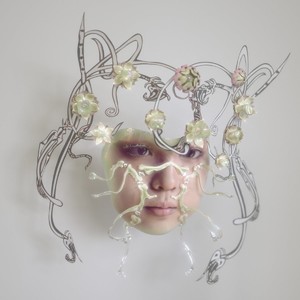
Re_B:rth collaboration with Jewel Y
You were also talking about collabs. What kind of talent do you like to collaborate with?
As long as I have an artistic connection or a good feeling with someone, all types of collaborations are possible, except for maybe with other 3D artists. I prefer working with people who have a talent that I don’t have, or a skill that I don’t go near. It is more rewarding and there are no ego battles. It’s not like I have a huge ego, but a lot of times when people do a similar type of work, it can be a real make-or-break situation. I like to collaborate with people who don’t have anything to do with my work: makeup artists, photographers, drag queens, musicians, visual artists, singers…
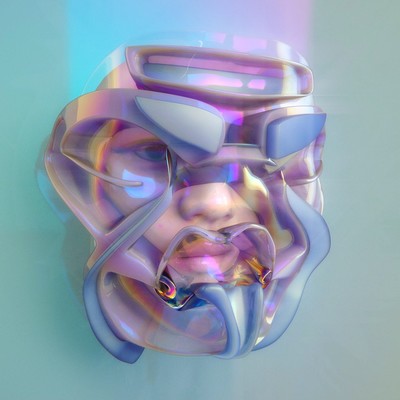
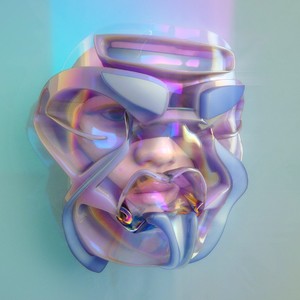
Toucan Space Collaboration
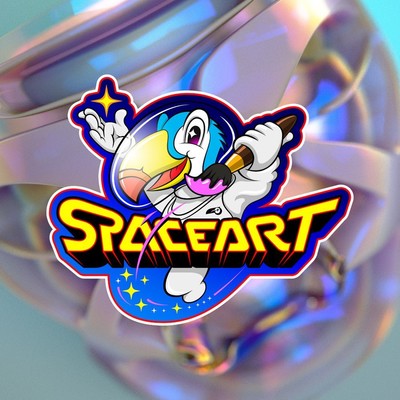
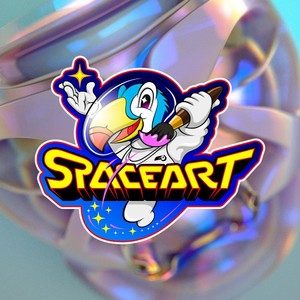
Toucan Space Collaboration
Graphic design I would imagine?
I still haven’t had time to do it, but there was Virgile Flores, a typographer who is on my list. Fashion brands, fashion designers: any collaboration is possible, and I can get inspired by just about anything. But my canvas will be that person’s face. And in terms of inspiration, it’s going to be their work, so either the person lets me get inspired by their work, their style, and their world, so that I can do something with their face, or we work together. Right now, for example, I’m in the middle of a collab with an artist called A1jewel. She creates masks out of faces. She designs and cuts them from tracing paper and it’s very pretty, very fine. She made herself a mask out of paper and I’m going to add 3D elements onto her face and her paper mask.
When did you leave the agency to create your own business? What was your vision?
Before I made my decision, I suggested to one of the bosses in the agency where I worked that we create an augmented reality and virtual reality (AR&VR) department. I was the creative director and at my last meeting I said, “We really need to create an AR&VR department.” And afterwards, I told them, “I really want to do this,” and I got my contract terminated. I think they were sad to see me go. I hope they admit now that I was a valuable member of the team. I left and I didn’t really know if I should start an AR&VR company. I had met Monochrome at the time. They are a company that does full VR, tons of VR experiences: headset, sublime… They’ve done a lot of collabs with huge museums, with DIOR. We did a collab with them withPANTEROS666where we made a VR clip and people came to the event to visit a spaceship. We made prints too. I was wondering, “Should I do VR? I wasn’t doing AR yet. I didn’t really go near it. I didn’t know which software to use. It seemed very complicated, so I started working on my own, and I said to myself, “I’m going to do 3D. I’m going to do 3D makeup. I’m going to do my collabs.” And in six months, a year, if it doesn’t work out, I’ll go back to advertising. And in fact, six months later, Nikesaid to me, “Do you want to do a project for us?” And I asked, “Are you sure?”


Nike × Zalando - Airmax2090
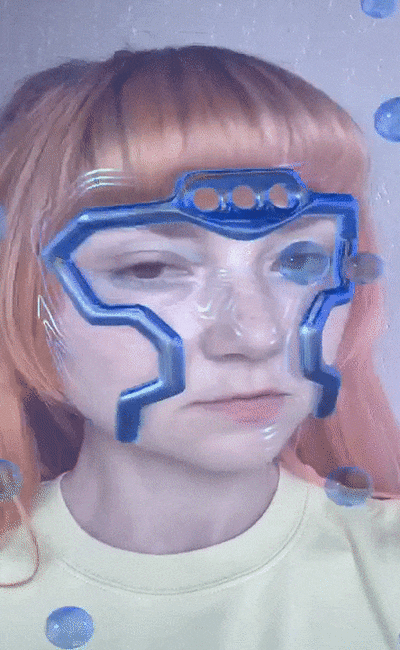

Nike × Zalando - Airmax2090
And if I ask you the same question today, where do you see yourself in 3 to 5 years?
Well, that’s more complicated. When you start out, you experience a boom. People want to work with you. That was a bit of a complicated time in my personal life. I was doing everything a bit robotically. I don’t even know if I truly appreciated it all. Still, I did some amazing collabs, but I don’t know if I really could appreciate them because everything was coming to me all at once. Things kept getting better as I got more propositions, and I couldn’t really believe it… I was doing conferences, exhibitions all over, and I was like, “How am I going to do this?” I don’t know how I didn’t just explode right then and there. But even in the moment, I didn’t know how to enjoy those incredible projects. I am completely aware of how fortunate I was to work with those awesome brands and some really cool, really talented teams. When I think back to it, I am extremely proud and happy with what I accomplished!
Right now, I’m doing this amazing collaboration that I can’t talk about but that should be coming out next year. It’s a major, long-term project. Foundational. I can’t wait for it to come out. I feel like it aligns really well with my work. But I have fewer requests than in the first two years. This current big project should allow me to shift my focus back to how I want to grow my work. It also gives me a chance to update all my computers. I can’t take it anymore. All this hardware stresses me out. I think it’s the thing that stresses me out more than anything else in the world.
When you say all your computers, how many do you have?
Right now, I have two: a big tower PC and a laptop. My laptop just bugged out on me while updating windows 11. I almost… I cried. Simply put. I couldn’t take it anymore… Blue screen on blue screen. I took it to a repair shop. I usually fix it myself, but I was so burnt out: I couldn’t take it anymore! I didn’t lose my files. Now everything is on DropBox. It’s the best invention. I am waiting for the next 4080 graphics card to revamp the tower. Since I like to move around, my goal was to only have a laptop and an external graphics card, so I also have an external graphics card, but it’s stupid because when I really need power, I have to use the PC. I can’t use my laptop’s external graphics card. And I’m like, “Why did I make this investment?” And you always have to update everything, the software, the licences. Since I work alone, I don’t want to have one licence for my PC and one licence for my laptop. That would be so expensive, so I have to switch between the two. I have to sign out of one to go onto the other. In short, it’s a real hassle…
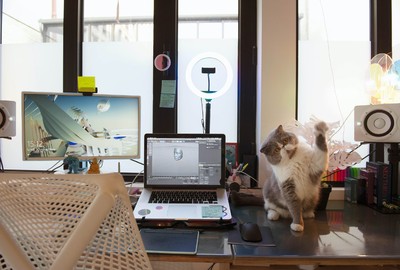

Office, Photo: Alexandre Haefeli
We’ve digressed, but this is a real deep dive into 3D life. Otherwise, you want to do long-term collabs, take time to reflect on how to sustain your success, and I suppose there are other developments as well?
What developments? Do I want to go full metaverse? Am I doing more https://danae.io/collections/7: NFTs? Is this really what I want to do? It’s such a blur, and this medium is so new… Of course, it is very interesting and makes sense with my work. I am super curious to know about the future of beauty and self-expression in this virtual world. But sometimes I think, “This world is kind of weird. Do I really want to go there? Is this thing truly good for us? Should I be doing physical artwork?” That’s another thing that bothers me.
Some CGI artists—and I don’t mean this is in a bad way—are doing this almost by default because they still don’t have the material or the opportunity to be a photographer or a director yet. But you, it’s in your DNA, yet you are thinking about doing physical work, is that right?
It might make sense. I did a collaboration with an artist called Anaïs Borielast year. She does stained glass, and she made this stained-glass mirror. And I did the reflection. In the mirror, there’s an iPad, a digital mirror that shows us another version of ourselves, brought to life and emphasised by the physical mirror, which is very particular. I’ve been thinking about doing things like this for a long time now and I thought I should find other artists to create other mirrors with. Hey, an iPad is cool, but it would be even cooler to have a Snow White mirror. A real magic mirror.
You talked about your first commission from Nike and a huge project you are currently working on. Were there any other turning points?
The confidential project is clearly a turning point. Nike was a major turning point, but so was Dior makeup. After that collab, all the beauty and luxury brands got interested in my work. These were the two major turning points. I gained a lot of visibility thanks to a collaboration with Sheidlina, a Russian artist. I’ll say too that I didn’t do the collab for that purpose. She came to my place. I met her. She was a girl I admired a lot. That was also a turning point, to have someone so talented and with so much reach who acknowledged my work. One of the first collaborations I did was with Charlotte Free, who was originally a model who did shows for Chanel when Karl Lagerfeld was around. She was one of the people I wanted to put on all my campaign mood boards. She was the first luxury runway model to have pink hair. And I was very stunned that she came to my house, that she was interested in my work.

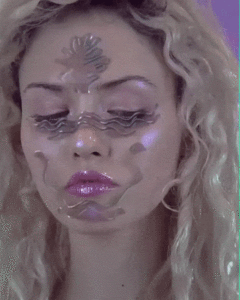
Collaboration with Moochild
If you could go back to your early days, what do you wish you had known? What do you know now that you didn’t know then?
I would say that every year I learned a lot of things, and still to this day, I learn a lot and continue to make mistakes. When I do conferences or workshops with students, I try to pass on as much as possible from what I have learned over the years: don’t work for free, say exactly what you’re going to do and what you’re not going to do from the very beginning. I mean, those are more professional or technical aspects. I also try to teach them to reflect on their own history and how to put their personal identity and experiences into their work to make it even stronger.


Managing expectations.
Yes, and it’s not a question of scaring the client, it’s as simple as, “Do you want this specific thing? I’m going to do this specific thing. However, I am not going to do that other thing. This thing will be done in this amount of time. I will need exactly this many days to do my job well.” It’s something that some clients understand while others are like, “Could we have this for tomorrow?” And no, it’s not possible, and it’s not healthy to accept that sort of thing. I know there are a lot of people who accept these last-minute jobs because they need to work, because it’s a good opportunity, because they need visibility, but I find it toxic to perpetuate these kinds of practices. It’s toxic for our community, especially since we already have a hard time gaining respect in terms of wages and working conditions. More respect would also benefit the clients. Taking one’s time to do things well, to reflect, not to go crazy doing something that is going to disappear in six months. No one will see it again. It’s on Instagram, and it won’t leave Instagram.
An art director we know has this expression he heard in England: “Don’t catch your client’s cold.” If your client is disorganised, be careful not to become like them just because they try to rush you.
Yes. And mostly this is a pity for the client. We are in a big machine, and we have developed bad habits over many years. A lot of re-educating needs to be done as far as that is concerned. Many clients think that they’ll be able to replace us with artificial intelligence, that that would be easier, that they could just pay for a software… And it’s true that certain clients wouldn’t be able to tell the difference in terms of quality of work. Luckily, there are clients that value what we do and that can tell the difference… but not all clients…
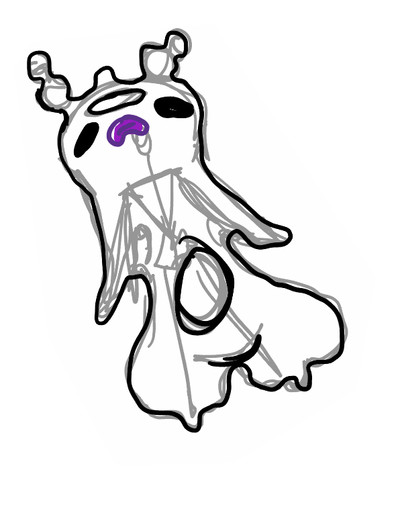

Sketch by Ines Alpha
Are you seeing any developments among the young CGI artists that are coming up?
It’s funny because I arrived on the 3D scene more or less at the beginning of the wave of new digital artists. It may have started before, I’m no expert, but I remember the seapunk trend. And it was also the beginning of Blender, a free 3D software. There were more and more 3D objects online, more and more tutorials and this entire new generation of artists who were saying, “Wow, 3D has become super accessible!” Because when I learned 3D at school—what a nightmare—I said to myself that I would never do this again. There was that first generation of artists where it was a bit… I mean, I’m thinking of people like Sabrina Ratté, Kim Laughton, Vince Mckelvie, of course, the first artists to start playing around with these digital tools. Is it Kim Laughton or Jon Rafman who tried to reproduce their dreams in 3D? Everything was sort of low def, everything looked a bit like Second Life. That has evolved with new software, but there’s still the same obsession with the future, with cyborgs, with blending… There are some more organic things, closer to nature, more blending of materials too because the rendering software is so much more advanced. But has the subject matter really changed that much? I am almost tempted to say that it’s gotten more dystopian! The seapunk wave was almost all fun and love, like a big Care Bear party. Nowadays, it’s much darker. Well… amongst the people I follow at least. And at the same time, seeing how the world is going, it makes so much sense! Even for me, this pre-apocalyptic environment is starting to influence my work!
We shouldn’t assume anything… but I imagine, from what you tell me about the development of your career, that you don’t consider yourself a strategist. Do you still have… people that inspire you strategically? Or even artists whose career management you appreciate?
The main artists I can think of are Pussykrew. They always manage to be inspiring, because of their ideas and how they manage new technologies and innovations. Everything is strong and consistent.

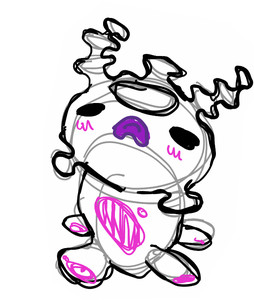
Sketch by Ines Alpha
How did you come up with the name Ines Alpha by the way?
My real name is Inès Marzat, and I wanted to keep Inès. I like my name. I like my last name, but I wanted to have a pseudonym. I wanted to separate myself a bit from Ines Marza, the art director, the human, my ID card. I wanted to make a change for my artistic career. In my work, there’s a layer in the images I export for post-production called the Alpha Channel. It’s an image in black and white. The white is the area around the object that you want to isolate. And the black takes away everything around it. And when I render an object in 3D to put the face on, I have to use this Alpha Channel to get only the 3D elements so that I can put them on a photo or video. I had a lot of issues, especially at the beginning, because I didn’t select the right boxes. The elements would not be properly isolated, I would have a missing image, I would have to re-render the whole thing, etc… I thought, this channel, it’s going to follow me everywhere. Alpha is a bit like Marzat, so it sounds good. Hence, Ines Alpha. Nothing to do with wolf packs. I thought about it later when people said to me, “Oh gosh, that’s a bit pretentious.” And I was like, “Huh?” But it’s the 3D Alpha Channel, nothing else.
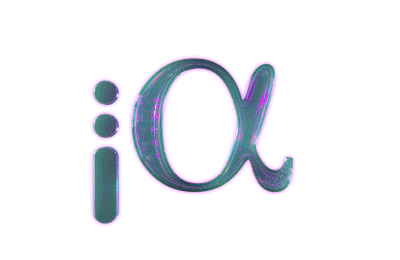
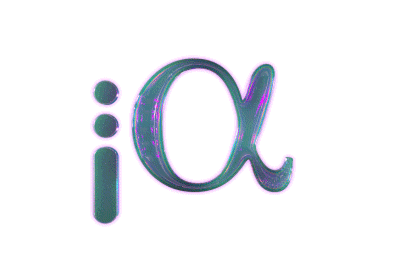
Ines Alpha Logo
Yes. The Alpha and the Omega. Idea for a pseudonym for another venture: Ines Omega?
Yeah, so I actually have a private TikTok—we don’t have to include this—called Inès Béta. And it is kind of a useless version where I don’t do 3D, I just do jokes. Inès Béta is me in the morning, unfiltered.
Cool! Let’s get back to Pussykrew with a K and their strategic approach.
Every time I see their work, I think I should unfollow them cause it makes me so frustrated (laugh). I met them because they were one of the first artists to do really cool 3D work, and they had done physical sculptures, blobs. At the time, I was obsessed with artists who were doing blobs. It was in fashion. And they had done an exhibition of their blobs that they had 3D printed then sanded and painted with car paint. It was very cool, very well done. And also, they’ve made a ton of videos for the artist Sevdaliza with great post-prod. They’ve done tons of VR experiences. They have done a bit of AR. Every time there’s a new medium, they use it in a super smart way. And so yeah, of course, they did a thing with artificial intelligence. It’s incredible. They evolve in a very natural way.
Who else could I name in terms of strategy or evolution? Sheidlina, this Russian artist, because her work is very—I don’t know if you know Mark Ryden—it’s very surreal, cute, kawaii, gothic. She started out by doing these somewhat surreal photomontages on Instagram. That’s how she got famous. Later, she did some 3D, and even asked me for advice! And as soon as she started doing 3D, it was so good. With anime, nice textures. She’s super good. She knew how to surround herself with the right people. She’s with a guy who is a photographer and who is willing to help her. He’s a bit like her Pierre Bergé. So not only does he help her with her photos, but also with management, finding an assistant, managing the workshop. She can just concentrate on the creative. She went to school in Florence, I think, because she wanted to do painting. She was already doing it some but she wanted to learn the technique and so she did painting, sculpture… she was doing great stuff after only a year or two. The same goes for NFTs. She did a super smart collection of NFTs with a photo of herself covered in pebbles and she sells each pebble as an NFT. The pebble only opens after 60 seconds. You buy a pebble, but you don’t know what’s inside. Buying it and opening it reminds me of toys in the 2000s and that’s what I’ve been waiting for from the beginning with NFTs. I like the surprise factor, the ability to collect them like in Japan, how they have all the little boxes with the little characters.
I think it’s possible to earn a lot of money with one project and to think you’ve earned so much that you should invest it, for example, in an exhibition.
The last time Sheidlina spoke to me, she said, “You know for my first exhibition, I had something built. I spent 20,000 Euros.” But me, right now, I can’t afford 20,000 Euros for an exhibition!


Collabortation with Charlie Le Mindu and Cameron Tidball-Sciullo
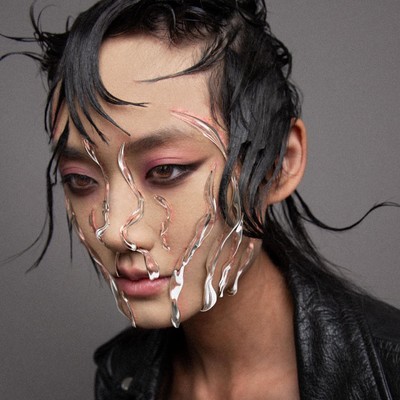
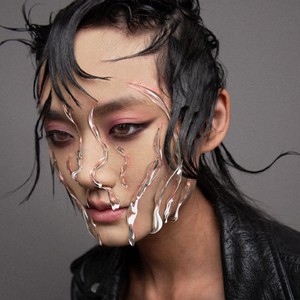
Collaboration with Charlie Le Mindu and Cameron Tidball-Sciullo
There are fashion photographers who spend 30,000 Euros on an editorial just to show brands that they can do exactly what they need…
I have trouble with that. I find it very difficult to take risks with money. I manage my finances “so well” that I only spend on material and even that… It took me 7 years to buy a new PC tower. Sometimes I really envy people that don’t have that fear, who understand risk and investment. But really, I just don’t have 30 grand!
It seems like you made a strategic decision, maybe by default— I’m not sure—to stay on your own. You don’t surround yourself with people, you don’t have a 3D assistant, and you don’t delegate much?
Yes, yes, yes. But it’s freelancers, not full-time people. It’s a question I’ve always asked myself. I tried once. I had an intern who worked remotely, it was just after Covid. But I didn’t like it that much. It stresses me out. But still, at the advertising agency…
Did you delegate?
Yes. I always had three or four art directors with me, and there was no problem delegating. And I liked to train people. But when it’s my own work, it’s not the same.
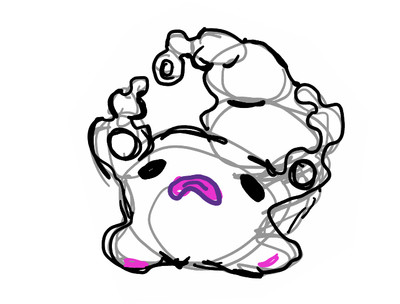

Sketch by Ines Alpha
But for example, you were talking about that Russian artist. She also has people that help her with management or overseeing projects. Even that, you do everything yourself?
Yeah, so now my agent helps me a bit with that.
How did you meet? Were you actively searching or was it an opportunity?
No, it was Kim (DVTK) and Leslie (Leslie David) who introduced me to the Management Artists people, and in the very beginning I was with an agent who did a great job negotiating my deal with H&M. It was one of my biggest collabs. It was really good. The subject matter was great. Everything went super well. I love the Swedes. They are so organised and so nice. It was really exciting. And then that agent left. Joseph, who is my agent today, was handling my project and at the time he asked me, “Should we give you a contract so that we can represent you officially?” And I wasn’t super comfortable with the contract because at the time, I didn’t really need people to bring me clients because they would contact me directly. I would say to them, “Well, if the clients contact me directly, you can’t take the same commission you take with photographers for whom you find clients because you aren’t doing the same work.” Then Joseph left Management Artists and we met up and I asked him what he wanted to do on his own and if he wanted to continue to represent me. We worked out a deal between the two of us and he said yes. So he doesn’t do any prospecting, but he does the negotiating for all the big-budget projects.
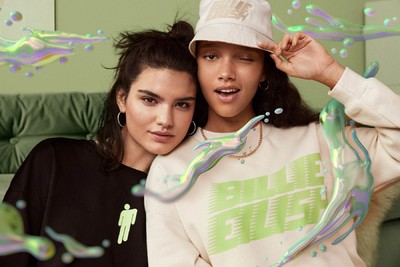
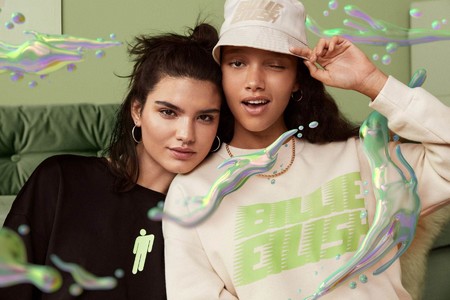
H&M


H&M
It’s still better to have an intermediary so you can avoid having to discuss all those issues.
Yeah exactly. He handles all of that. But for example, I don’t know to what extent I can involve him in… I don’t like project management, but when there are big projects like the one with H&M, where I have ten videos with a thousand different formats and a filter and that is all spread out across many formats… Luckily, there was Mathematics TV with a project director. To do the execution and to check that all the right formats were there. But lately, I’ve been doing a lot of filters, so I don’t need that. I have a well-organised Notion with one box for each client.
You use Notion as well?
Yeah, it’s so good. I have my little boxes and my agent is on it, but really, for the moment, I haven’t needed to update things too much. And it’s true that when I create a filter. I take a client brief, I do the sketches, I send that to the client, there is some back-and-forth, and I turn it into 3D. If I need a freelancer to help me with 3D or AR production, I handle that myself. It’s true that I don’t envision a moment where I could put someone between me and the freelancer, unless it were a big thing and there were a ton of things to do, then I would need someone to handle everything and make sure all is in order.
You said that all the clients come to you. Have you ever done any prospecting?
So, in the very beginning, because I was quite eager, I thought that luxury brands made a lot of sense for 3D on faces for an advertising campaign and for creating sort of futuristic-looking cyborgs. I tried to contact Balenciaga, by the way, and got totally ignored. I think I sent maybe three emails to three different people. It’s not a big deal. It happens. It wasn’t the right time. Maybe the brand wasn’t made for what I do. I tried anyway.
Your professional development also had a lot to do, I imagine, with Instagram and your collabs.
It’s never out of cynicism, of course, but there’s still a strategic element when we say, “I’m prioritising visibility.”
Yeah, it’s true that when I was starting out, in all the creative fields, you had to be on Instagram for visibility. It was the main outlet. I didn’t do the collabs to gain visibility, but I did see that it was a good idea to do them.

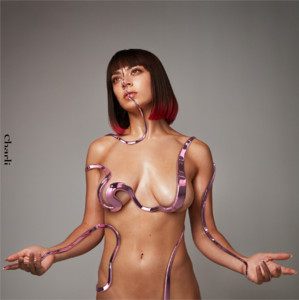
Collaboration with Charlie XCX
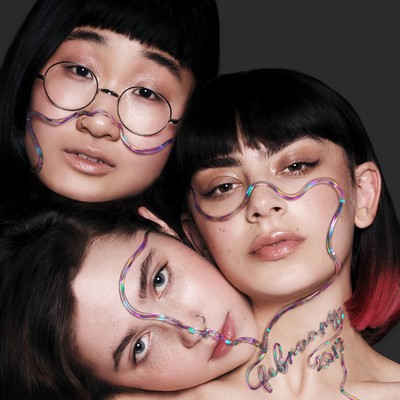
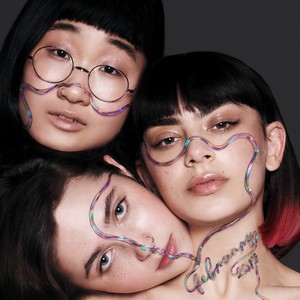
Collaboration with Charlie XCX
And what do you think of Instagram now?
Same as everyone else, it’s very aggravating. It’s sad because when you build a community, you also build your portfolio and no one else sees things. I have fewer views, fewer likes, less of everything than when I had 10,000 followers. Now I have 160,000. It’s ridiculous, truly ridiculous. And it’s horrible to think that the people who follow you because they like your work don’t see it.
It’s the false “free” nature of social media that makes us go on it. It was very useful for quite a few studios and incredible artists, but on our own, we are all trapped. The thinking among the creatives we meet seems to lean towards recapturing control of one’s own platform. Returning to websites, for example. Because Instagram was the portfolio, and people didn’t even work on their websites anymore. Could there be a new Tumblr? With more curated reposts than new media?
I agree. And I was even hopeful about NFTs because I thought there would be a new platform, kind of like Instagram, except that each thing you post would have a value. But there are so many platforms. It’s horrible, you’ve got three things in one spot, two things over there, one thing over here.
About that, how would you describe the state of the current market? I guess you already talked about the metaverse, you’re suspicious. How do you see NFTs? Are they an editorial opportunity for CGI artists?
The fact is that we can finally sell a digital work. Because before… giving a USB key, you could copy the mp4, the JPEG. It wasn’t protected. Or you could sell the whole screen with the video inside of it? But how do you stop the person from having another video on the screen? I know that, for example, there is this artist, Rafael Rozendaal, who sells websites so that you own the domain like the blabla.org. And his work is a website, a visual piece that you buy the URL to and that you can’t do anything else to. This process was very interesting to me. With NFTs, it makes this process more accessible to everyone. Unfortunately, it has become a kind of war machine, a money machine. It’s hard to change humans. It has taken on completely ridiculous proportions. And people are mistaking NFTs for art. They are clearly two separate things. For me, the NFT is a medium, a tool that allows for the sale of digital art. Just because you put some JPEG, a tweet, or some disgusting old monkey face… Just because those monkeys are NFTs doesn’t mean they are art. What was that guy’s objective? It was just to make monkeys. Was this an artistic objective? I don’t know. And just because it’s worth billions today doesn’t mean that it’s art and that, aesthetically, there’s something going on that there’s any emotion to it. I don’t know who feels something when looking at those monkeys, except the feeling of stuffing their wallet. I’m badmouthing a little, but that stuff is just not what moves me. That stuff was a bit of a bust. Maybe that will help shift the focus of this tool onto what counts and what NFTs will really be used for. Selling contracts that are somewhat intelligent, and thus set in stone. Having your work scattered across a thousand platforms, it’s a pain. I’m a visual person and I want to have all my pieces in one room, one place where everything is pretty and well presented. It’s not about feeling you are better or worse than other artists, but sometimes you want to be on a platform with artists who are doing what you are into. You can consider the curation of this or that platform because they won’t expose you to the same audiences.
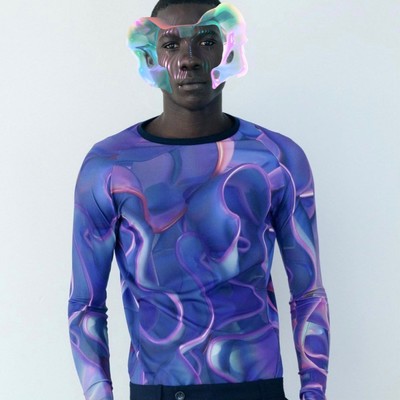

Collaboration with Mansour Martin

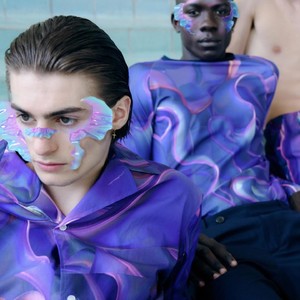
Collaboration with Mansour Martin
And about the metaverse more broadly, you alluded to what Kim and David from DVTK want to do, to turn the web back into a space for creativity even though many things have been standardised. Do you have a similar view on the metaverse?
Well, the Internet is already a metaverse, a sort of parallel world where we communicate but that isn’t the physical world. But there are many metaverses, and therefore many platforms. Second Life was a metaverse. To me, Fortnite is also a metaverse because you make your avatar, you have your money, your little custom clothes, and all that… a Travis Scott concert.
You can go to a concert and do things you can’t do in real life. For me, that’s what the metaverse is all about. I don’t see the point in creating an alternate reality to replicate our world. On some of the platforms I’ve tried, there’s already a consumerism aspect. We’re going to reproduce shops, all the consumers, all the brands. The first idea they have: let’s recreate a store.
We’ve noticed that you share stories that are somewhat political, with strong views like what you just said. Do you do this spontaneously? How do you make the decision to communicate on these subjects?
Yes, it’s not easy because it’s not my job to be political. And I’m not an expert on all subjects. I don’t want to repost information that I don’t know a lot about, so from time to time, I repost information that other people have thought a lot about, that I find well written, that opens the discussion and allows for reflection. Any statements that are a bit too radical, I don’t share, even if sometimes I agree with them. What is important is to open the discussion and say, “This thing exists. This problem might exist. Let’s talk about it.” For instance, with NFTs, I posted a story where I said, “Okay, I understand that environmentally-speaking, it’s a serious concern. I still want to take part in the adventure. I still want to experiment. I am going to be careful. Sadly, I am going to do a few things with Ether, but the goal in the future will be not to do Ether until they provide ‘proof of stake.’” I like talking with my community, interacting, and learning. I have political opinions, but it’s not my job to be political. What I do is more like casting little bottles into the sea: What do you all think? Can you open the bottle?
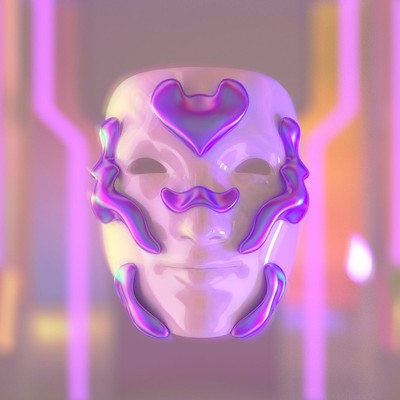

Snapchat Lens

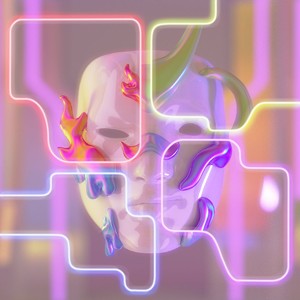
Snapchat Lens
And you keep yourself very well informed. You talk about community. You name a lot of cool references. How do you do that? Do you dedicate time to it, or do you do it naturally without realising it?
I spend far too much time on social media.
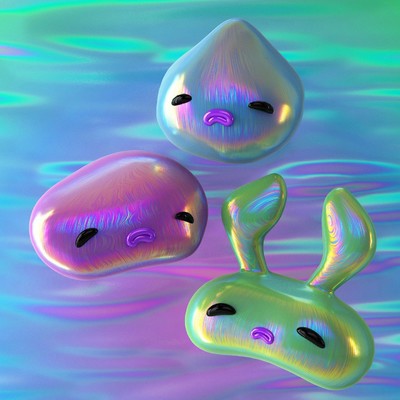
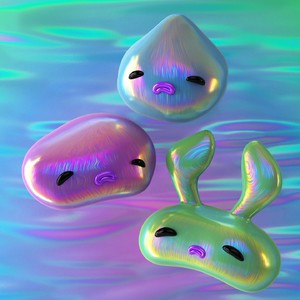
Work for Snapchat Spectacles glasses
Yes, but seeking things out, not just being passive. Isn’t it an active time?
Yes, I inform myself. I’m trying more and more to mark certain people on my Instagram as “favourites.” Because as you said earlier, we follow a lot of people. It is difficult to sort through everything. I want to see everyone’s work, but then I wouldn’t work.
Let’s end with some more trivial questions. If you had to do another job during another period in history, what would it be and when?
At another time in history? The first thing that comes to mind would be to be a makeup artist in the 1970s or 1980s… Even a special effects makeup artist for science fiction. Honestly, I don’t have many other ideas. I feel like our era is very cool… UNLESS I was to be a digital makeup artist in 3022. Of course, if we had saved the planet and found symbiosis between nature and technology…
Is there one book that helped you think better about your profession? Or several? A book, a reference, it could even be fiction, but is there one that made an impression on you and that oriented you creatively?
I’ve read a lot of books on beauty. There’s this book by Lipovetsky. I love Lipovetsky. Every time I read his books, I find them so true and so good, and then I can’t describe the book. I’ve read like 6 or 7 of them. There’s one that’s about beauty that was very good. When I started my work, I didn’t really have a social or political leaning. And as I did more interviews, I thought, “No, I have to keep looking.” And I realised that, ever since I was a little, I’ve had complexes: Am I pretty? Do I have to be a woman? What is my identity? Do I express myself well? Do I have to fit in? Or do I have to be different? And why does society impose so many standards on us? I’m a white girl. I already have privilege. I’ve got a small mouth, no breasts. I’m lucky to be thin. Well, during the 1990s and 2000s, that was in style, and I was still dieting like crazy to be thin. And anyways, I started asking myself all these questions: why is this being imposed on us? Later I discovered RuPaul’s Drag Race and thought, wow, there are people who express themselves so well and who have enormous freedom to transform themselves into a bunch of different people. You should be able to walk down the street and see these people walking around too, it’s so cool. But that’s not how things are. That’s why I read tons of books on where this pressure comes from and the standards imposed on men and women, especially women, but also on men really. You can’t just go and put a skirt on and walk down the street when you’re a cisgender heterosexual man. It’s a problem: skirts look super good on you guys.
I am not some big intellectual either. Recently I started reading A Thousand Plateaus by Deleuze and wondered if I was really going to be able to read that whole thing. The answer? No, LOL. So now I’ve started a new Lipovetsky book on seduction.

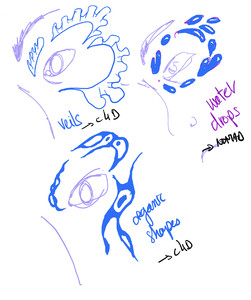
Sketch by Ines Alpha
On sexuality, there’s Michel Foucault, but it is complex. Start with Pascal Quignard’s Sex and Terror. It’s very good, didactic while maintaining a high level of reflection. You mentioned a lot of artists who inspire you. But are there any who have also made your practice evolve?
So, the first person that came to me, but I really think it’s the right answer, is an artist called Clara Bacou. And it’s because she pushed me to do AR. Because I didn’t think I was capable of doing it. I thought that the software was super hard. It was Lens Studio at the time. It was the first somewhat accessible AR software. And she said to me, “Of course.” So she pushed me in the literal sense.
She’s an inspiration too, of course.
She is a human inspiration, but her work is also brilliant. Wait, let me think. It’s mostly people who are involved with physical art more than with 3D. Still though, when I see certain artists doing things with artificial intelligence or whatever, I think, “Damn, these are some people with good ideas.”
So, the last question: any advice for people who want to start a career on their own?
I’m a Capricorn, Taurus rising. So yes, I am extremely pragmatic and very careful. If I don’t have a parachute, I don’t jump. Even with a parachute, I find it difficult to jump. It scares me to death. You can die at any moment. A little breeze, and boom! I would say, take baby steps. And beyond mum’s advice, if it brings you pleasure, you are on the right track. Sometimes you do things because it’s trendy, because you like the artist and you’re inspired, because you think it’s what you have to do to please clients. But that’s not how you create something new, your own style, your own identity, a type of work that is personal. And sometimes, creating your identity means doing something that is directly connected to your story, your culture, your trauma. And sometimes, it has nothing to do with what you see around, so you say to yourself, “No, no one does that. I’m not going to do that. It’s useless.” But if while you’re doing that thing, you say to yourself, “Actually, I like this thing,” then you must keep doing it.
